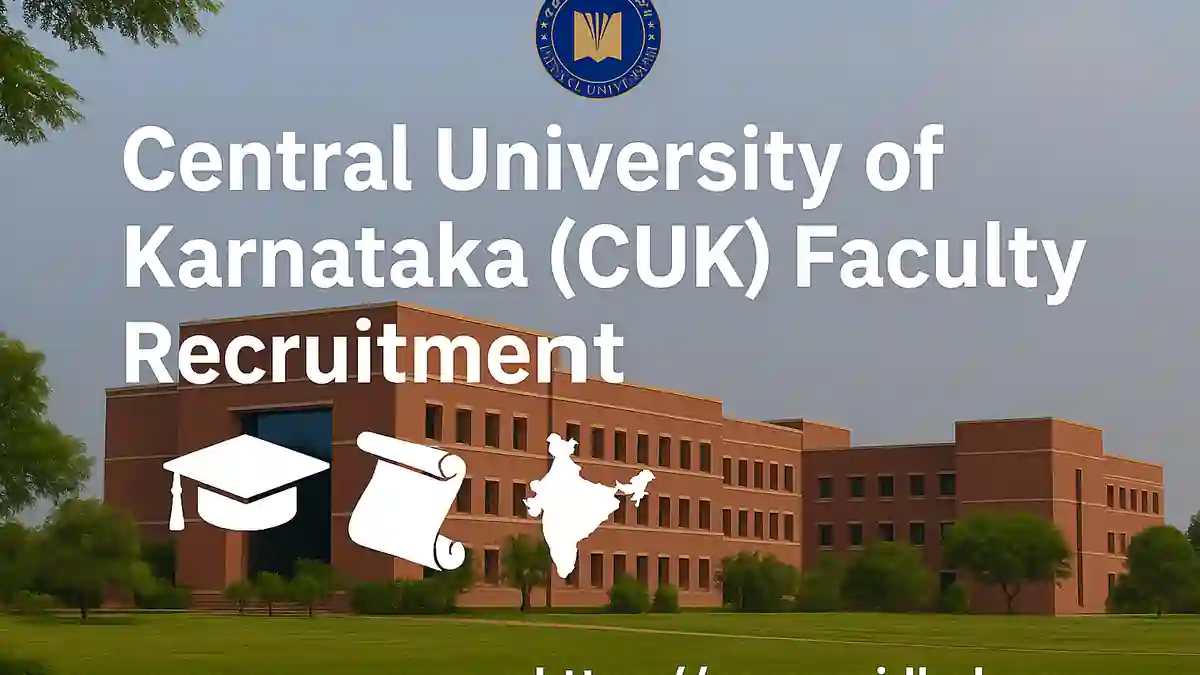Central University of Karnataka (CUK) Faculty Recruitment — Notification No. 40/2025
Central University of Karnataka (Kalaburagi) has issued Notification No. 40/2025 inviting applications for teaching positions across select departments. The call is live on the CUK website and mirrored on the UGC–Samarth recruitment portal, confirming that applications are open and must be filed through the official system.
Central University of Karnataka (CUK), Kalaburagi, has announced new teaching positions under Notification No. 40/2025. Applications are invited through the official university notice and the UGC–Samarth portal. Prepare a complete, well-evidenced dossier to maximize shortlisting prospects and submit early to avoid portal congestion during the closing phase.
What This Round Covers (At a Glance)
-
-
Positions: Teaching posts (Professor / Associate Professor / Assistant Professor) as per the department-wise distribution specified in the notification.
-
Mode: Online submission through the UGC–Samarth recruitment portal; all supporting documents must be uploaded exactly as the portal checklist requires.
-
Where to find the notice: CUK homepage notice board (Notification No. 40/2025) and the Samarth/UGC advertisement listing.
-
Closing month: October (the exact last date will be updated soon on the portal). Submit several days in advance to avoid traffic surges near the deadline.
-
Expected Next Cycle
(Indicative)
Based on typical central university schedules, the next announcement is likely in January; the subsequent closing window may align with March/April. Exact months will be updated soon once the university publishes the schedule.
Eligibility, Norms, and Pay Structure
Recruitment follows UGC Regulations for academic cadres, including the API/Research Score framework and minimum qualifications appropriate to discipline and level (e.g., Ph.D.; Master’s with NET or equivalent where prescribed). Moreover, the pay matrix and reservation policies conform to Government of India/UGC norms. Departments list post-wise qualifications and roster points in the official notice and on the portal entry.
Department-wise specializations are normally detailed in the PDF/portal entry. If your research area closely aligns but is not identical, demonstrate fit by mapping your work to documented teaching requirements, ongoing departmental initiatives, and any curricular revisions recently adopted at CUK.
How to Apply (Step-by-Step)
1) Access the Advertisement
Review CUK → Notifications for “Notification No. 40/2025,” then confirm the same details on the UGC–Samarth listing. Note any portal-specific file or size constraints before compiling your dossier.
2) Create/Verify Your Samarth Profile
Register on the Samarth (UGC) recruitment portal if applying for the first time. Keep name, email, ORCID, and identifiers consistent across
3) Prepare Your Dossier as Separate PDFs
-
-
CV (reverse-chronological; include Scopus/Web of Science IDs where relevant).
-
Research plan (2–4 pages): immediate objectives, facilities required, collaborations, and external funding targets.
-
Teaching statement (2 pages): courses you can deliver immediately; proposed electives; learning outcomes and assessment approach.
-
Publication list with DOIs; emphasize first/corresponding-author papers, patents, or technology transfers.
-
Evidence files: degree certificates, category/reservation certificates, experience letters, invited talks, major grants, and Ph.D. guidance data if applicable.
-
4) Complete the Online Form Carefully
Enter your discipline/specialization exactly as listed. Map publications to UGC Research Score fields where relevant. Upload clear, legible PDFs, compress responsibly, and verify every file after upload.
5) Fee Payment & Final Submission
If an application fee applies to your category, pay it within the portal and retain the receipt. After final submission, download the application PDF and record your application number for future correspondence.
6) Hard-Copy Requirement (If Any)
Some central universities require hard copies within a defined time after online submission. Therefore, check the instructions section of the
What to Emphasize in Your Application
A. For Assistant Professor
-
-
Methodological depth: experimental techniques, computational workflows, or field methods that translate immediately into courses and labs.
-
Pipeline to outputs: a 12–18-month plan with target journals, student supervision, and small-grant roadmaps.
-
B. For Associate Professor
-
-
Independent trajectory: sustained first/corresponding-author outputs; Ph.D./PG supervision; extramural funding as PI/Co-PI.
-
Departmental service: curriculum design, accreditation roles, and industry or outreach linkages.
-
C. For Professor
-
-
Group leadership: multi-investigator grants, centre development, or large consortia.
-
Institutional impact: doctoral program strengthening, lab infrastructure building, standards/policy contributions.
-
Shortlisting, Interviews, and Selection
-
-
Shortlisting adheres to UGC norms and considers essential qualifications, research record, and discipline-specific needs stated in the notification.
-
Seminar/colloquium: Many departments request a teaching demo and/or research talk ahead of the selection committee interaction—prepare both versions succinctly.
-
Original documents must be presented during interview or appointment for verification.
-










